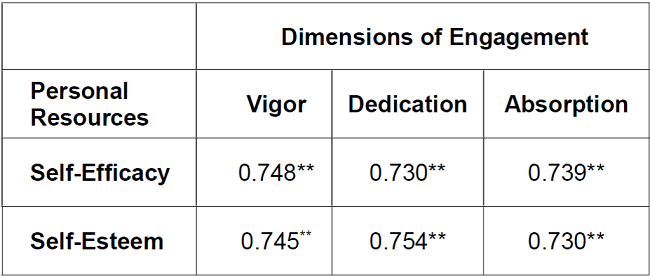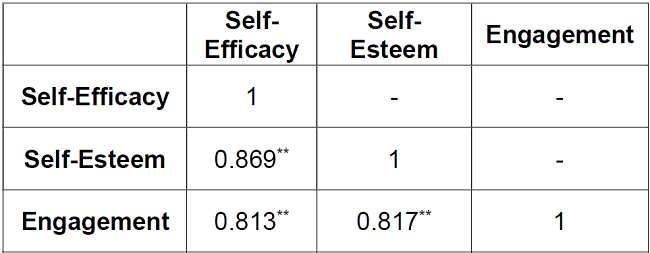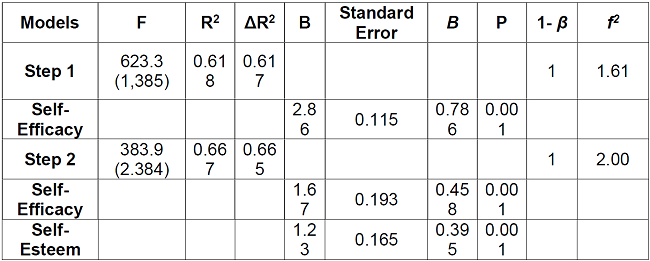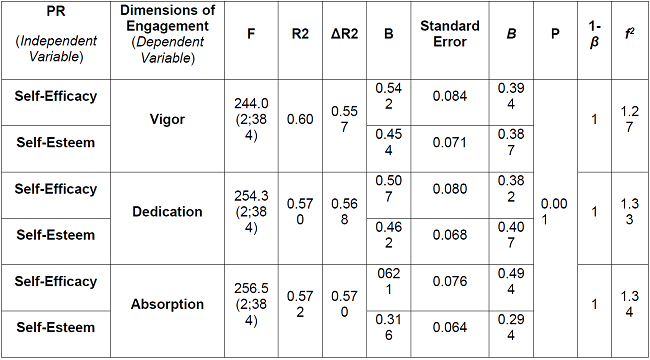Mi SciELO
Servicios Personalizados
Revista
Articulo
Indicadores
-
 Citado por SciELO
Citado por SciELO -
 Accesos
Accesos
Links relacionados
-
 Citado por Google
Citado por Google -
 Similares en
SciELO
Similares en
SciELO -
 Similares en Google
Similares en Google
Compartir
Enfermería Global
versión On-line ISSN 1695-6141
Enferm. glob. vol.22 no.70 Murcia abr. 2023 Epub 26-Jun-2023
https://dx.doi.org/10.6018/eglobal.528511
Originals
Self-efficacy, self-esteem and engagement among Peruvian nurses during the COVID-19 pandemic
1Full time professor at the Universidad ESAN, Faculty of Economics and Administration. Lima. Perú
2Faculty of Psychology. Universidad Nacional Mayor de San Marcos. Lima. Perú
Introduction:
Nursing professionals have faced the COVID-19 pandemic and health crisis on the front lines. Caught without technical and material readiness, as well as without previous experience, they resorted to using their own resources such as self-esteem and self-efficacy to raise their performance and uphold their commitment to public health. It has been reported that one third of the 37,000 nurses working in Peru contracted COVID-19, and approximately 180 died from the virus.
Objectives:
Measure the influence of personal resources on engagement among professional nurses during the COVID-19 pandemic.
Methods:
Cross-sectional explanatory correlational research from a sample of 387 Peruvian nursing professionals. A descriptive and inferential statistical analysis was performed. IBM SPSS Statistics V/26 software was used.
Results:
The results showed highly significant and positive correlations between the variables self-efficacy, self-esteem and engagement. Likewise, predictive values of more than 50% of personal resources on engagement were identified.
Conclusions:
Professional nurses during the pandemic perceived themselves with an average level of self-efficacy, high levels of self-esteem, and a medium level of engagement. Personal resources, self-efficacy and self-esteem, were able to predict the engagement of professional nurses in the dimensions of vigor, dedication and absorption.
Keywords: Self Efficacy; Self Esteem; Engagement; COVID-19
INTRODUCTION
The COVID-19 pandemic posed new challenges to public health. Healthcare professionals took on the crucial challenge of facing the pandemic with only the material and personal resources they had available to them. In addition, they received strong public pressure to improve their performance and deliver optimal results in the face of this challenge. Studies carried out by Pang et al.1, Yörük and Güler2 and Melchor et al.3 on the pandemic and its impact on the emotional health of healthcare professionals showed that anxiety, depression and emotional exhaustion became their most common mental disorders. But at the same time, other studies such as those carried out by Gamboa4 and Jackson and Usher5 show the resilience of health professionals in the face of the pandemic.
Prior to the pandemic, studies demonstrated that nursing professionals are commonly subject to demanding working conditions and exhibit multiple psychological reactions resulting from the interaction of personal and organizational factors6. It has been shown that many health professionals exhibit emotional exhaustion, low achievement and high levels of depersonalization6. However, opposite psychological reactions have also been observed mainly in situations of high pressure where motivational factors drive commitment, safety and quality of care7. In this sense, psychological responses become polarized into two constructs. At one extreme is burnout syndrome (emotional exhaustion) and at the other extreme is engagement (commitment). Maslach and Leiter8 propose that engagement is a phenomenon opposite to burnout and that its dimensions of energy, involvement, and efficacy are the opposites of emotional exhaustion, depersonalization, and low personal accomplishment.
Engagement, a term coined by Kahn9, describes a positive psychological state at a cognitive and affective level, which is maintained over time. At the work level, engagement implies the worker's effort to advance improving performance10. This state of mind not only generates positive experiences, but also gives satisfaction at work11.
For Schaufeli and Bakker12, engagement, in addition to being a cognitive and emotional state directed to assigned tasks, is made up of three dimensions: vigor, dedication, and absorption. Vigor is characterized by mental toughness, high energy level, a willingness to invest effort into the work, and persistence despite difficulties13. Dedication is understood as a high commitment to the work and the feeling of delivering meaningful work. And finally, absorption involves a state of deep concentration, a feeling of well-being for the work done, and satisfaction with the results obtained.
Concepts of personal resources have their origin in Hobfoll's theory of conservation of resources (COR)14. Xanthopoulou et al.15 establish three core personal resources: self-efficacy, self-esteem, and optimism. All three of which are recognized by Hobfoll14 as fundamental components of individual adaptability.
Self-efficacy refers to an individual's perception of their ability to perform effectively in the face of various demanding contexts. This belief-being effective and accumulating personal accomplishments, and based on positive experiences-extends to other situations. This gives the individual the ability to perform tasks successfully, to set more challenging goals, and even to allow persistent behaviors to emerge over time, even after the task is finished.16 Previous studies show that self-efficacy maintains a positive relationship with engagement17.
From an organizational perspective, self-esteem is understood as the degree to which employees believe that they can satisfy their requirements by actively cooperating with specific persons within the organization. The research of Mauno et al.18, a longitudinal study carried out on medical personnel in Finland, revealed that organizational self-esteem is one of the substantial predictors of engagement.
Moreira et al.19,20 showed that personal resources, positive emotions, and institutional support are predictive factors of engagement. Huamán21 found that there is a highly significant relationship between self-esteem and job performance among nursing professionals at a hospital in metropolitan Lima, Peru. Irigoín22, who carried out an investigation in the city of Cajamarca, Peru, found that 92% of the participants from eight health establishments exhibited a high level of self-efficacy and concluded that health professionals had their own optimal capacities to successfully carry out health activities entrusted to them.
The purpose of this research was to measure what effect nursing professionals' self-efficacy and self-esteem have on their engagement in the context of increased demand for their effort due to the COVID-19 pandemic.
METHODS
This quantitative research is cross-sectional and has an explanatory scope. The research was carried out in Peru, one of the South American countries hardest hit by the COVID-19 pandemic. Data collection was carried out from October to December 2021. The population consisted of 102,900 nursing professionals from public hospitals. A non-probabilistic sample was selected for convenience because of the ease of access researchers had via social networks and contacts through access to professional nurses associations’ databases. An anonymous and voluntary online self-administered questionnaire, disseminated by the researchers, was used. The sample size was 382 professionals. They were asked to fill in an informed consent form. The data was anonymous in order to guarantee confidentiality.
To measure personal resources, two scales were used. The first was the Baessler and Schwarzer General Self-Efficacy Scale (GSE)23, which consists of ten items over four grades, where the first grade means "Very Uncertain" and the fourth grade "Very Certain". Its Cronbach's alpha coefficient was 0.75. The second was the Rosenberg Self Esteem Scale (RSES)24 which is made up of 10 items and uses a scale ranging from 1 = Strongly disagree, to 4 = Strongly agree. Its Cronbach's alpha coefficient was 0.73.
To measure engagement, the simplified 15-item version of the Utrecht Work Engagement Scale (UWES) by Salanova, Schaufeli et al. was used25. The instrument measures three dimensions: vigor, dedication, and absorption. The scale has seven degrees, ranging from 0 = Never to 6 = Daily, obtaining a Cronbach alpha coefficient of 0.94. These results indicate that all the instruments and tools used during this investigation are reliable.
The following procedure was used. Requested permission from the authors for the adaptation of the Self-efficacy, Self-esteem and Engagement instruments. Prepared the online questionnaire, which included the informed consent and the specific items for each of the instruments. This was then deployed using Google Forms. A total of 428 questionnaires were collected, of which 46 were excluded due to errors in filling them out, or inconsistencies in the results. Obtained 382 valid questionnaires.
For the statistical analysis and processing, the IBM SPSS Statistics V/26 software was used. The data was analyzed with descriptive statistics and measures of central tendency in order to obtain the distribution of frequencies and percentages, and inferential statistics with the correlations and multiple linear regressions.
RESULTS
The demographic profile of the participants was as follows: 83% female and 17% male. As for the ages: youth ages 22-29, 41%; young adults ages 30-45, 53%; adults ages 46-60, 6%. Regarding the time of service: 1 to 6 years, 56%; 7 to 12 years, 31%; 13 to 30 years, 13%.
Table 1 shows the results of the descriptive analysis. It shows the minimum and maximum scores, the mean, and the standard deviation for each of the variables analyzed. It shows the average of each variable at different levels (low, medium and high). The result of the normality test-using the Kolmogorov-Smirnov test-did not reflect a normal distribution, having a level of significance less than 0.05. And a non-parametric statistical analysis (Spearman's correlation) was performed.
Table 1: Descriptive statistics and proportion of the variables.

Notes:n=387; K-S=Kolmogórov-Smirnov;
**p<0.01
Correlation Analysis
Spearman's correlation coefficient was applied and the following results are given in the Table below:
Table 2 shows that the correlation between the personal resources of self-efficacy, self-esteem, and engagement are highly significant with a Spearman’s correlation coefficient (ρ=0.385), which shows a positive or direct correlation (above 0.80), as well as a high significance level (p<0.01).
Regarding the correlations among the variables self-efficacy, self-esteem and the three dimensions of engagement, Table 3 was obtained:
Table 3: Correlation of self-efficacy, self-esteem and dimensions of engagement.

Note:**p<0.01; n=387
The results shown in Table 3 reflect that the correlations made between self-efficacy and self-esteem, and each of the dimensions of engagement were highly significant for Spearman's correlation coefficient (ρ=0.385) since it exceeded 0.70 with a high level of significance (p< 0.01). This clarified the sense of positive and direct relationship between the variables self-esteem or self-efficacy against the variable engagement .
Multiple Regression Analysis
The step method analysis of multiple linear regressions showed that the variables self-efficacy and self-esteem (independent variables) predicted the variable engagement (dependent variable) by 66.7%, as expressed in Table 4. The results showed that when incorporating variables into the model, this had greater explanatory power over the dependent variable (engagement), as well as a higher level of statistical power and effect dimension, since they exceeded the high and significant indices, 0.80 and 0.35, respectively as explained by Leongómez in his article Statistical power analysis and sample size calculation in R26.
To determine if the dimensions of the dependent engagement variables (vigor, dedication and absorption) had any degree of explanatory power for the self-efficacy and self-esteem variables, an input linear regression was carried out. Table 5 showed that self-efficacy and self-esteem (independent variables) explain each of the dimensions of the variable engagement (dependent variable), namely vigor, dedication and absorption in 56%, 57% and 57.2%, respectively.
DISCUSSION
Based on these results, the variables self-efficacy and self-esteem are highly correlated with the variable engagement for nursing professionals in the context of COVID-19 in Peru.
This is in contrast to what was found in the studies by Pang et al.1 Yörük and Güler2 and Melchor et al.3 about the impact of the COVID-19 pandemic on the emotional health of front-line health professionals, who presented high levels of depression, anxiety and burnout. Also, this is in contrast with studies of health crisis situations prior to the pandemic carried out in countries such as Chile,27 Colombia28 and Peru6 where nursing professionals would have low self-esteem, low self-efficacy and low levels of engagement. The results of this study show that nursing professionals improved their engagement during the scenario marked by the health crisis. And these findings seem to be consistent with other emerging studies carried out in recent years, as shown by Gamboa et al. 4 and Jackson and Usher5 that the pandemic allowed nursing professionals to show their resilience and work commitment.
This new line of research seems to confirm previous studies such as those by Mäkikangas et al.17 who found significant positive relationships of medium intensity between personal resources and engagement. Both Salanova, Schaufeli and others25,17 came to identify that self-efficacy and self-esteem are related to persistence, dedication and satisfaction during the performance of their activities, manifesting their own behaviors and strongly linked to the dimensions of engagement: vigor, dedication and absorption.
Previous findings together with the results of the present investigation seem to confirm that personal resources such as self-efficacy and self-esteem imply positive self-assessments linked to the self-perception of the ability that professionals have to control and influence their environment. Such self-assessments preFigure goal setting, motivation, job performance and even satisfaction such that they generate commitment to the activities undertaken.
In line with these findings, increasing engagement during a health crisis in turn increases people’s expectation and belief in self-efficacy.
In the context of a health crisis, such as the COVID-19 pandemic, these results show that instead of producing burnout syndrome in nursing professionals, levels of commitment (engagement) increase. In other words, the functions performed by nursing professionals in the midst of the crisis become beneficial to their self-esteem, since it seems that the crisis is the scenario that confirms the importance, significance and value of their professional work.
As can be seen in the results, self-esteem is the most relevant personal resource among nursing professionals, coinciding with the results found by Mäkikangas et al.17, the results of research such as those of Bhatti et al.29 are reinforced. Bakker and Demerouti30 find that health professionals have a greater involvement in their work, because they tend to have greater intrinsic motivation and better adaptation to changing contexts.
The results seem to show that self-efficacy improved in the midst of the health crisis, and these results are related to previous research such as the study by Hernández and Oramas31, who, in a similar sample of healthcare personnel, found a significant relationship between self-efficacy and engagement. Self-efficacy is related to factors such as persistence, dedication and satisfaction in their work, which in turn allows them to adequately manage certain stressors in their environment.
For their part, Bakker and Demerouti30 obtained results that showed that a higher level in the vigor dimension was mainly due to the influence of resources such as self-efficacy and self-esteem affecting the job performance of care workers. Vigor refers to the energy and persistence that professionals invest in their work environments during the performance of their duties. It seems that the vigor of nursing professionals increased in the midst of the health crisis, due to an improvement in their self-esteem and self-efficacy.
The data collection procedure has only been accomplished since the online channel does not allow the capture of more information about the feelings and expressions related to the items of each test. Although the results obtained through this research are statistically representative compared to the universe (95% confidence and +- 5% margin of error), it is necessary to carry out confirmatory studies on the real effect of the pandemic on the emotional health of healthcare professionals. Although it seems that salient characteristics of the studied population activate their best personal resources in crisis contexts. Additional studies taking into account other personal resources, including optimism or resilience, may be explanatory, regardless of the level of knowledge and certainty in the face of ambiguity.
CONCLUSIONS
With these results, and in the context of the COVID-19 pandemic, it is concluded that nursing professionals faced the health crisis displaying their best personal resources, their self-efficacy and self-esteem, and this in turn contributed to improving their levels of work commitment, their engagement.
Throughout the study, highly significant correlations between the variables were shown, so it can be concluded that self-esteem and self-efficacy are correlated with engagement in nursing professionals.
The data obtained show that the personal resources of self-efficacy and self-esteem predict the commitment of nursing professionals in the dimensions of vigor, dedication and absorption, so it is concluded that among these professionals, and despite the health crisis, there was a strong commitment and a feeling of total involvement towards their work.
These results, which are contrasted with other studies, seem to show that in situations of health crises in which professionals face an unfamiliar phenomenon, and in a context of high uncertainty, such as the COVID-19 pandemic, the hierarchical levels of knowledge among health professionals disappear and it is the personal resources that emerge in such a context of crisis.
This study highlights the need to understand the real effects of the pandemic on the emotional health of nursing professionals. Given that they are distinct from the other medical staff and health professionals, nurses showed their commitment based on their personal resources.
REFERENCIAS
1. Pang Y, Fang H, Li L, Chen M, Chen Y, Chen M. Predictive factors of anxiety and depression among nurses fighting coronavirus disease 2019 in China. Int J Ment Health Nurs. 2021; 30(2): p. 524-532. [ Links ]
2. Yörük S, Güler D. The relationship between psychological resilience, burnout, stress, and sociodemographic factors with depression in nurses and midwives during the COVID-19 pandemic: A cross-sectional study in Turkey. Perspect Psychiatr Care. 2021; 57(1): p. 390-398. [ Links ]
3. Melchor A, Jiménez M, Solano J, Simón L, Gaya B, Bordonaba D. Análisis del impacto psicoemocional de la pandemia del COVID-19 entre los profesionales de enfermería. Enf Global. 2022; 21(2): p. 184-223. [ Links ]
4. Gamboa L, Becerra K, López Y, Goicochea E. Nivel de resiliencia del personal de salud frente a la pandemia por Covid-19. Rev. Cuerpo Med. HNAAA. 2021; 14(1): p. 49-54. [ Links ]
5. Jackson D, Usher K. COVID-19: Resiliencia y la Fuerza Laboral de los Profesionales de Enfermería. Investigación en Enfermería: Imagen y Desarrollo. 2020; 22: 1-. 2020; 22(1). [ Links ]
6. Arias W, Del Carpio A. Síndrome de burnout en personal de enfermería de Arequipa. Rev Cub Salud Pública. 2016; 42(4): p. 559-575. [ Links ]
7. Días C, Teixeira A, Oroski G, Conceição M. Gestión del equipo de enfermería: factores asociados a la satisfacción en el trabajo. Enferm. Glob. 2017; 47: p. 193-207. [ Links ]
8. Maslach C, Leiter M. Understanding burnout: New models. The handbook of stress and health: A guide to research and practice. 2017;: p. 36-56. [ Links ]
9. Kahn W. Psychological Conditions of Personal Engagement and Disengagement at Work. Acad. Manage. J. 1990; 33(4): p. 692-724. [ Links ]
10. Contreras F, Espinosa J, Esguerra G. Could Personal Resources Influence Work Engagement and Burnout? A Study in a Group of Nursing Staff. SAGE Open. 2020. [ Links ]
11. Orgambídez A, Borrego Y. Apoyo social y engagement como antecedentes de la satisfacción laboral en personal de enfermería. Enfermería Global. 2017; 16(4): p. 208-225. [ Links ]
12. Schaufeli W, Bakker A. Defining and measuring work engagement: Bringing clarity to the concept. Work engagement: A handbook of essential theory and research. Psychology Press. 2010. [ Links ]
13. Cernas D, Mercado P, Davis A. Perspectiva Futura de Tiempo, Satisfacción Laboral y Compromiso Organizacional: el Efecto Mediador de la Autoeficacia, la Esperanza y la Vitalidad. Rev. psicol. trab. organ. 2018; 34(1): p. 1-9. [ Links ]
14. Hofboll S. Social and psychological resources and adaptation. Rev. Gen. Psychol. 2002; 6: p. 307-324. [ Links ]
15. Xanthopoulou D, Bakker A, Demerouti E, Schaufeli W. Reciprocal relationship between job resources, personal resources, and work engagement. J. Vocat. Behav. 2009; 74(3): p. 235-244. [ Links ]
16. Tadic M. Recursos Personales y Compromiso laboral: un estudio en dos fases sobre el papel de los recursos laborales entre los enfermeros. Investigación Social. 2017; 28(1): p. 5-24. [ Links ]
17. Mäkikangas A, Feldt T, Kinnunen U, Mauno S. Does personality matter? A review of individual differences in occupational well-being. Adv. Posit. Organ. Psychol. 2013; 1: p. 107-143. [ Links ]
18. Mauno S, Kinnunen U, Ruokolainen M. Job demands and resources as antecedents of work engagement: A longitudinal study. J. Vocat. Behav. 2007; 70(1): p. 149-171. [ Links ]
19. Moreira E, García M, Conde A, Gonzales A. Autoeficacia, recursos laborales y emociones positivas relacionadas con las TIC de los docentes: sus relaciones estructurales con la motivación autónoma y el compromiso laboral. Inform. Educ. 2019; 134: p. 63-77. [ Links ]
20. Bakker A. Job crafting among health care professionals: The role of work engagement. J Nurs Manag. 2018; 26(3): p. 321-331. [ Links ]
21. Huaman Z. Autoestima y su relación con el desempeño laboral de las enfermeras del Hospital Daniel Alcides Carrión, Callao. Universidad Nacional Mayor de San Marcos. 2017. [ Links ]
22. Irigoín J. Nivel de autoeficacia laboral en profesionales de los esTablecimientos de salud de la ciudad de Cajamarca. Universidad Privada Antonio Guillermo Urrelo. 2018. [ Links ]
23. Baessler J, Schwazer R. Evaluación de la autoeficacia: adaptación española de la Escala de Autoeficacia general. Ansiedad Estrés. 1996; 2(1): p. 1-8. [ Links ]
24. Rosenberg M. Self Esteem and the Adolescent: Society and the Adolescent Self-Image. Princeton University Press. 1965. [ Links ]
25. Salanova M, Schaufeli W, Llorens S, Peiró J, Grau R. Desde el 'burnout' al 'engagement': ¿una nueva perspectiva? Rev. Psicol. Trab. Organ. 2000; 16: p. 117-134. [ Links ]
26. Leongómez J. Análisis de poder estadístico y cálculo de tamaño de muestra en R: Guía práctica (Versión 3). Zenodo. 2020. [ Links ]
27. Veliz A, Dörner A, Soto A, Arriagada A. Bienestar psicológico y burnout en profesionales de atención primaria de salud en la región de Los Lagos, Chile. Acta univ. 2018; 28(3): p. 56-64. [ Links ]
28. Quiroz E, Muñoz J, Salazar A, Ocampo F, Vanegas N. Engagement y burnout en profesionales de la salud colombianos. Salud y Ciencia. 2020; 24(4): p. 201-207. [ Links ]
29. Bhatti M, Alshagawi M, Syah A. Mediating the role of work engagement between personal resources (self-efficacy, the big five model) and nurses' job performance. International Journal of Human Rights in Healthcare. 2018; 11(3): p. 176-191. [ Links ]
30. Bakker A, Demerouti E. Towards a model of work engagement. Career. Dev. Int. 2008; 13(3): p. 209-223. [ Links ]
31. Hernández L, Oramas A. Factores psicosociales laborales relacionados con el work engagement desde el modelo de demanda-recursos laborales en trabajadores cubanos. Revista Cubana de Salud y Trabajo. 2018; 19(2): p. 19-23. [ Links ]
Received: June 18, 2022; Accepted: November 12, 2022











 texto en
texto en 





